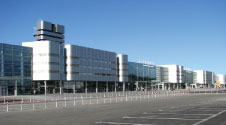
Ekaterinburg Koltsovo Airport handled 3.4 million passengers in 2011, with international passenger numbers increasing by 39%.
The last decade was a period of radical transformation at Ekaterinburg Koltsovo Airport, which put in operation modern passenger terminals with a combined capacity of 8 million passengers per year. In addition, the airport invested in the overhaul of Runway 1, introduced state-of-the-art airport systems, and upgraded technical facilities.
In that time, the airport has also seen a rapid recovery of passenger traffic figures. In 2011, Ekaterinburg Koltsovo Airport handled approximately 3.4 million passengers, making it the busiest year in two decades. International passenger numbers rose by 39% last year. Plans for the future include apron overhaul and extension, new aircraft stands, adding new airfield technical facilities and modern equipment.
Connecting regions
In the face of dynamic growth in recent years, transformation away from a regional airport and towards a fully-fledged hub has become Koltsovo’s primary development objective. Koltsovo Airport’s CEO, Evgeniy Chudnovskiy, said: “Ekaterinburg Airport enjoys favourable conditions for achieving this goal: unique geographical location, high business activity of the Urals and Siberia, well-developed airport infrastructure with ample capacities and wide existing network of flights.”
Certainly, having a home carrier helps, but orderly work is underway to add destinations and increase frequencies across the board. “Effective build-up of the airport’s transfer capacity, primarily through the development of the regional feeding, and setting up convenient connections to long-haul flights remain our priorities,” added Chudnovskiy.
In June 2010, a regional services development programme was launched, and Koltsovo Airport supported the opening of five new destinations and the increase of frequencies in four other regional markets. As a result, the Koltsovo timetable gained 21 flights a week. Further impetus to the regional development was given by the airport’s acquisition of four 30seat Embraer 120 aircraft, which were then leased out to RusLine. “That enabled Koltsovo to restore a number of regional links lost in the post-Soviet period and to offer passengers an affordable alternative to the previously inevitable connections in Moscow,” explained Chudnovskiy.
The regional network development is a good fit for the airport’s multimodal mail and freight village project. This project includes the construction of a new cargo terminal and an automated sorting centre for Russian Post. The cargo terminal construction began in June 2011; at present, about 17,000sqm are fully operational. This allows for comfortable accommodation of the cargo terminal, office buildings of the airport’s cargo division and of Koltsovo Customs. Phase 1 of the investment amounted to 1.2 billion Rubles (€30m); further investment is spread through to 2025.
Sharing expertise
Successful implementation of its own development programme and a quality approach to airport asset management have enabled Koltsovo to win tenders for managing airports in other Russian cities – Nizhny Novgorod and Samara. “A single company is being set up, which will manage the three airports,” said Chudnovskiy. “We have gone through all stages of creating modern airport infrastructure: we have optimised passenger handling costs and technological processes; we have built up a strong team in a short time. Today, Koltsovo is operating at the level of good foreign airports, and – logically – we begin to export our airport management experience to other parts of Russia.”
Koltsovo will direct 2.7 billion Rubles (€65m) to the infrastructure development projects of Nizhny Novgorod International Airport. The programme envisages a new passenger terminal to be commissioned in 2014; the terminal will have a total area of 20,000sqm, a capacity of 600 passengers per hour, and be equipped with two air bridges. In Phases 2 and 3 (2014–2020), these parameters will be upgraded according to actual passenger numbers, projected to reach 1 million per year by then.
The Samara Kurumoch Airport renovation programme involves building a 35,000sqm terminal, with a capacity of 3.5 million passengers per year, by the end of 2014, which could be extended to 60,000sqm in line with demand.







